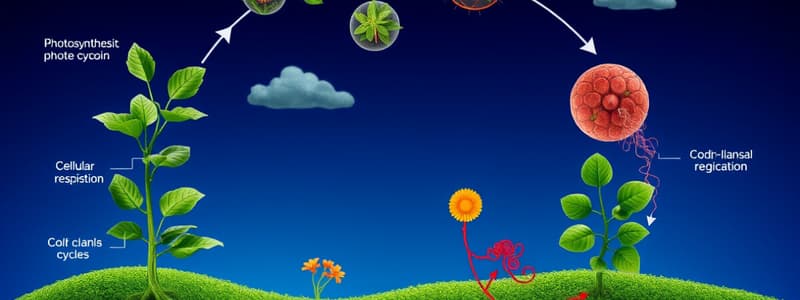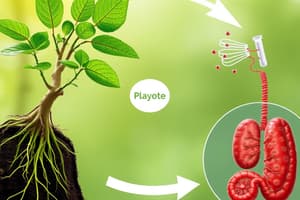Podcast
Questions and Answers
What process is used to extract fossil fuels that are highly dispersed throughout bedrock?
What process is used to extract fossil fuels that are highly dispersed throughout bedrock?
- Electrolysis
- Hydraulic fracturing (correct)
- Thermal extraction
- Molecular distillation
What materials are primarily used in the fracking fluid?
What materials are primarily used in the fracking fluid?
- Oil and natural gas
- Saltwater and minerals
- Water, sand, and chemicals (correct)
- Carbon dioxide and nitrogen
What energy process occurs in nuclear power plants that involves splitting large atoms?
What energy process occurs in nuclear power plants that involves splitting large atoms?
- Chemical reaction
- Radiation
- Fission (correct)
- Fusion
What is a major environmental concern associated with fracking?
What is a major environmental concern associated with fracking?
What theorem helps explain the relationship between energy and mass in nuclear reactions?
What theorem helps explain the relationship between energy and mass in nuclear reactions?
What process do plants use to convert carbon dioxide into carbohydrates?
What process do plants use to convert carbon dioxide into carbohydrates?
Which of the following describes cellular respiration?
Which of the following describes cellular respiration?
What type of storage involves carbon that is not immediately cycled back into the atmosphere?
What type of storage involves carbon that is not immediately cycled back into the atmosphere?
Energy is defined in physics as the ability to do what?
Energy is defined in physics as the ability to do what?
Which of the following types of energy is stored as chemical bonds?
Which of the following types of energy is stored as chemical bonds?
Which units are commonly used to measure energy?
Which units are commonly used to measure energy?
How does the majority of carbon dioxide fixed by autotrophs eventually return to the atmosphere?
How does the majority of carbon dioxide fixed by autotrophs eventually return to the atmosphere?
What is the primary difference between renewable and non-renewable resources?
What is the primary difference between renewable and non-renewable resources?
Which process is NOT used to generate electricity from fossil fuels?
Which process is NOT used to generate electricity from fossil fuels?
What type of fossil fuel is primarily used for heating homes and generating electricity?
What type of fossil fuel is primarily used for heating homes and generating electricity?
What is a consequence of burning fossil fuels?
What is a consequence of burning fossil fuels?
What is coal washing used for?
What is coal washing used for?
How are fossil fuels formed?
How are fossil fuels formed?
What role does the law of conservation of energy play in energy transformation?
What role does the law of conservation of energy play in energy transformation?
What is flue gas desulfurization used for?
What is flue gas desulfurization used for?
Which of the following is NOT considered a renewable energy resource?
Which of the following is NOT considered a renewable energy resource?
What is a major issue associated with coal burning?
What is a major issue associated with coal burning?
Flashcards are hidden until you start studying
Study Notes
Carbon Cycle and Energy Storage
- Carbon serves as a structural element in living organisms and is crucial for energy storage and transfer.
- During photosynthesis, plants convert carbon dioxide (low potential energy) into high-energy carbohydrates, harnessing light energy.
- Cellular respiration in plants and animals reverts carbohydrates into carbon dioxide and water, releasing energy and returning CO2 to the atmosphere.
- Generally, most carbon fixed in photosynthesis is quickly respired back into the atmosphere, while some carbon remains sequestered for longer periods, such as in buried organic material and coral exoskeletons.
- The short-term carbon cycle actively cycles a small percentage of Earth’s total carbon among the atmosphere, living organisms, and oceans.
Understanding Energy
- Energy is defined as the ability to perform work or induce change, measured in Joules (J).
- Energy can be categorized into kinetic (energy of motion) and potential (stored energy) forms, further subdivided into thermal, electric, and nuclear types.
- Energy sources are classified as renewable (replenished quickly) or non-renewable (finite and depleting).
- All energy forms can transform into one another, often losing some energy as heat, adhering to the law of conservation of energy.
Energy Sources
- Energy sources include non-renewable options such as coal, oil, wood, and gas, and renewable options like wind, water, and solar.
- Transforming energy sources into usable forms requires conversion to heat or electricity.
- Heat generation involves burning fossil fuels, while electricity generation uses turbines powered by steam or direct mechanical forces from wind or water flow.
Renewable vs Non-Renewable Resources
- Renewable resources (e.g., wind, water, geothermal) self-replenish and can generate electricity without permanently depleting their source.
- Non-renewable resources, chiefly fossil fuels (crude oil, natural gas, coal), are finite and formed over millions of years from decomposed organic matter.
- Conserving resources is vital for sustainability and mitigating global warming impacts.
Characteristics of Fossil Fuels
- Fossil fuels originate from ancient organisms and consist predominantly of coal, oil, and natural gas.
- Formation occurs under heat and pressure in oxygen-limited environments, resulting in hydrocarbons used as energy sources.
- Advantages of fossil fuels include high energy density, low cost, and broad availability, but they generate carbon dioxide and pollutants when combusted, contributing to air and water pollution and climate change.
- Fossil fuels currently account for about 84% of global energy consumption.
Environmental Impact of Coal
- Burning coal presents environmental challenges, primarily emitting carbon dioxide and impairing air quality.
- Carbon dioxide is a greenhouse gas that exacerbates global warming through the greenhouse effect.
- Emerging technologies, such as coal washing and carbon capture and storage (CCS), aim to mitigate the environmental impact of coal usage.
Exploration and Extraction of Fossil Fuels
- Hydraulically fracturing (fracking) enables extraction of dispersed natural gas and oil from rock formations.
- This method incorporates drilling and injecting pressurized fluid to create fissures and facilitate fossil fuel flow.
- Fracking has environmental drawbacks, including substantial water use and chemical contamination risks.
Nuclear Energy Fundamentals
- Nuclear energy is derived from atomic nuclei through fission (splitting large atoms) or fusion (combining small atoms).
- Fission reactions, common in nuclear power plants, release energy when uranium atoms absorb excess energy and particles and become unstable.
- Fusion, occurring in stars, fuses hydrogen into helium, releasing massive energy due to mass conversion, emphasized by Einstein's mass-energy equivalence principle.
Studying That Suits You
Use AI to generate personalized quizzes and flashcards to suit your learning preferences.




